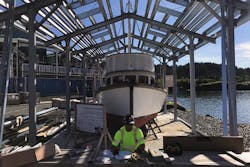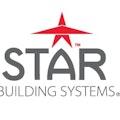Historic fishing vessel finds home in star-built pavilion
All too often, relics of maritime history are lost before they’re even recognized as the treasures they are. Luckily, the Thelma C—a 36 foot salmon seine vessel—has found a permanent home at the Kodiak Maritime Museum in Kodiak, Alaska. The outdoor pavilion exhibit site, designed by Barnes Architecture and constructed by contractor Friend Construction using Star Building Systems’ pre-engineered elements, was completed in December 2018.
Building History Through Loss
The Thelma C was built in 1965 for the original owner, Ken Cristoffersen, by Commercial Marine in Seattle, Washington, from a design by marine architect William Garden. Utilizing a Federal relief loan to build the Thelma C following the destruction of his original vessel, the Christine, during the 1964 Great Alaskan Earthquake and tsunami, Cristoffersen went on to fish off the Thelma C until his retirement. Subsequent owners continued to use the boat for fishing purposes until 2006 when its last working owner, fisherman Mark Thomas, donated it to Kodiak Maritime Museum.
Although one of many that were constructed using the Federal loan in subsequent years following the quake, it is believed that the Thelma C is the last surviving original wooden seine.
In 2012, restoration began on the vessel led by shipwright Brian Johnson (a previous owner of the Thelma C), and master woodworker Don Corwin. Using the original design plans, Johnson and Corwin replaced ribs and planks, rebuilt the mast, and reconstructed the flying bridge. It is the intention of Kodiak Maritime Museum to continue work on the Thelma C with experienced shipwrights and volunteers in an effort to keep wooden shipbuilding methods alive.
A Piece of Maritime History Gets Beached
Following the ship’s donation, plans began on the construction of a long-term exhibition site. Although the original design used conventional construction, Star Building System’s Kodiak partner, Friend Construction, was able to simplify the build by utilizing pre-engineered elements.
“The architect had a structural guy doing the building and then they were going to componentize the rest of the materials—the trim and roofing materials,” explained Joe Hanson, District Sales Manager for Star Building Systems. “Star’s solution was a bolt-together total package. That cuts out trades and saves money.”
Using an all-on-one solution meant the team was also able to engineer a product that could withstand the 160 mile-an-hour winds that can rush through Kodiak. With Star’s BattenLok HS® roof panels, the team was able to build an architecturally visual structure that was able to pass local wind requirements.
The Difficulties of Building in Alaska
However, using pre-engineered products didn’t hinder on-site design changes that elevated the original design, explained Hanson. Working with the architect, six skylights were placed into 5 foot by 5 foot curbs in the structure’s roof. Again, needing to design a structure that could withstand 160 mile-an-hour winds, the penetrations needed to be exactly engineered and placed to allow plenty of natural light while being structurally sound, even in the most extreme conditions.
Of course, building in Alaska has its own special challenges beyond the weather. Getting a pre-engineered structure to Kodiak meant manufacturing in Seattle, Washington, then transporting it via barge up the coast.
But in the end, it was worth it, particularly for Hanson. “I actually commercial fished as a young man. [During the planning phase] I traveled twice to go talk to the board about ‘go with Star; go with Friends [Constractors]; go with an all-in-one solution.’”
The project is also special in that Star and Friends Contractors partnership has become something unique.
“The significance of [Friends Contractors] is that it’s a woman-owned, 8(a) set-aside company,” (part of the Business Development Program), explained Hanson. “Brenda Friend grew up on Kodiak Island; she’s a native Alaskan. Gerald [Friend] was the mayor of Kodiak. They’re really cool people.”
Creating a structurally sound, all-in-one solution with Friend Contractors meant participating in a project that was truly local—designed, constructed, and finalized by those from the community that was able to give the Thelma C the respect and care it deserves as a socially important artifact.
Now at home in its outdoor pavilion, the Thelma C works as a interpretive exhibit for the Kodiak Maritime Museum. Visitors are able to not only view the ship, but understand how it was built and used during its time on the sea.
Hanson smiled, “I saw a real opportunity to do a historic feature right in downtown Kodiak. It was great.”

